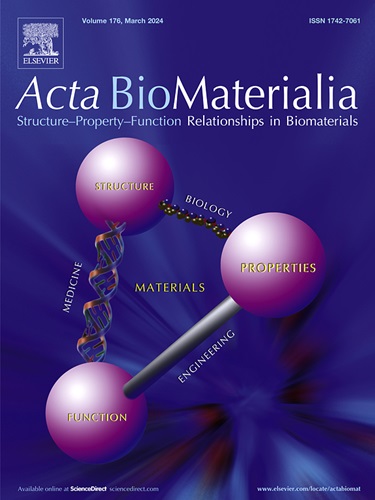具有一氧化氮释放的腐蚀基光热纳米复合水凝胶用于糖尿病伤口愈合。
IF 9.4
1区 医学
Q1 ENGINEERING, BIOMEDICAL
引用次数: 0
摘要
由于持续的细菌感染和血管生成受损,慢性糖尿病伤口的处理仍然是一个重大挑战。在此,我们报道了一种纳米复合水凝胶(M/P-SNO/G)与M/P-SNO纳米颗粒结合的纳米复合水凝胶(M/P-SNO/G),该纳米复合水凝胶由光敏性单羧基苯酚(MCC)和s -亚硝基硫醇修饰的聚乙二醇(mPEG-SNO)的超分子组装而成,用于光热疗法(PTT)/一氧化氮(NO)协同治疗糖尿病伤口。M/P-SNO中聚集的MCC之间强烈的π-π相互作用增强了M/P-SNO的光吸收和光热能力,从而促进了激光照射下NO的精确释放。由氧化透明质酸和羧甲基壳聚糖通过席夫碱交联组成的水凝胶基质具有良好的可注射性和自愈特性,为伤口修复提供了理想的环境。正如预期的那样,M/P-SNO/G具有良好的光热性能和可控的激光响应NO释放,在体外实现了增强的杀菌效果和抗生物膜能力。在糖尿病小鼠全层皮肤缺损模型中,M/P-SNO/G已被证明具有细菌清除和血管生成的有效作用,显著加速伤口愈合。本研究提出了一种可行的超分子策略来开发具有PTT/NO协同治疗的糖尿病伤口敷料。意义声明:开发先进的敷料,同时消除细菌和加速伤口恢复是治疗糖尿病伤口的必要条件。本研究开发了一种纳米复合水凝胶(M/P-SNO/G),具有光热治疗(PTT)和一氧化氮(NO)治疗的协同作用,可加速感染糖尿病伤口愈合。水凝胶内的M/P-SNO NPs通过疏水光敏单羧基共聚物(MCC)和亲水no释放聚合物(mPEG-SNO)自组装,其中高度聚集的MCC分子确保了优越的光热性能。同时,光热效应引起的温度升高激活了NO从水凝胶中释放。在660nm激光照射下,M/P-SNO/G表现出PTT/NO协同作用,有效抑制细菌增殖,促进血管生成,在糖尿病创面修复中具有显著的益处,进一步扩大了corroles的生物医学应用。本文章由计算机程序翻译,如有差异,请以英文原文为准。

Corrole-based photothermal nanocomposite hydrogel with nitric oxide release for diabetic wound healing
The management of chronic diabetic wounds remains a significant challenge due to persistent bacterial infections and impaired angiogenesis. Herein, we reported a nanocomposite hydrogel (M/P-SNO/G) incorporated with M/P-SNO nanoparticles engineered by supramolecular assembly of the photosensitizing mono-carboxyl corrole (MCC) and S-nitrosothiol-modified polyethylene glycol (mPEG-SNO) for synergistic photothermal therapy (PTT)/nitric oxide (NO) treatment of diabetic wounds. The strong π-π interaction among aggregated MCC in M/P-SNO enhances the optical absorption and photothermal ability, thereby facilitating the precise release of NO upon laser irradiation. The hydrogel matrix, composed of oxidized hyaluronic acid and carboxymethyl chitosan crosslinked by Schiff-base, demonstrates good injectability and self-healing characteristics, providing an ideal environment for wound repair. As expected, M/P-SNO/G exhibits a desirable photothermal performance and a controlled laser-responsive NO release, realizing enhanced bactericidal effect and anti-biofilm ability in vitro. In a full-thickness skin defect model on diabetic mice, M/P-SNO/G has proven effective in bacteria clearance and angiogenesis, significantly accelerating wound healing. This study presents a feasible supramolecular strategy to develop diabetic wound dressings with synergistic PTT/NO treatment.
Statement of significance
Developing advanced dressings that simultaneously eliminate bacteria and accelerate wound recovery is essential for treating diabetic wounds. This study developed a nanocomposite hydrogel (M/P-SNO/G) featuring the synergistic effect of photothermal therapy (PTT) and nitric oxide (NO) treatment to accelerate infected diabetic wound healing. M/P-SNO nanoparticles within the hydrogel are self-assembled through the hydrophobic photosensitizing mono-carboxyl corrole (MCC) and the hydrophilic NO-releasing polymer (mPEG-SNO), where highly aggregated MCC molecules ensure superior photothermal performance. Meanwhile, the temperature increase induced by the photothermal effect activates NO release from the hydrogel. Under 660 nm laser irradiation, M/P-SNO/G demonstrates a PTT/NO synergy to effectively inhibit bacterial proliferation and promote angiogenesis, offering significant benefits in diabetic wound repair and further expanding the biomedical applications of corroles.
求助全文
通过发布文献求助,成功后即可免费获取论文全文。
去求助
来源期刊

Acta Biomaterialia
工程技术-材料科学:生物材料
CiteScore
16.80
自引率
3.10%
发文量
776
审稿时长
30 days
期刊介绍:
Acta Biomaterialia is a monthly peer-reviewed scientific journal published by Elsevier. The journal was established in January 2005. The editor-in-chief is W.R. Wagner (University of Pittsburgh). The journal covers research in biomaterials science, including the interrelationship of biomaterial structure and function from macroscale to nanoscale. Topical coverage includes biomedical and biocompatible materials.
 求助内容:
求助内容: 应助结果提醒方式:
应助结果提醒方式:


